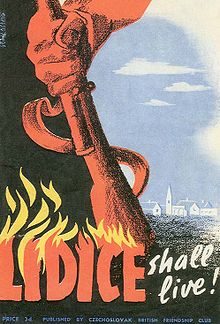Barnett Stross
He served twenty years as a Labour Party Member of Parliament, famously led the humanitarian campaign "Lidice Shall Live" and pushed for reforms in industry to protect workers.
At a time prior to the existence of a welfare state in Britain, Stross gave medical care without charge to the poorer members of Stoke-on-Trent's communities.
[2] His medical experience was often called upon when other MPs, Lords and members of the public present in the Palace of Westminster felt ill.
He also led a campaign to rebuild Lidice, a Czechoslovak village which had been destroyed by Nazi forces during the Second World War in a 1942 massacre under orders from Adolf Hitler, who was enraged by the assassination of Reinhard Heydrich by British-trained Czech resistance fighters.
Immediately after news of the event reached Stoke-on-Trent he spoke to miners and their leaders, proposing the reconstruction of the village of Lidice to commemorate this crime against humanity forever.
"[3] An audience of 3,000 men and women heard Dr Beneš's concluding remarks: "This meeting has made it clear that Lidice has not died: it lives on in the hearts of the people of Stoke-on-Trent at least.
In the months that followed, from its base in Stoke-on-Trent fund-raising campaigns were organised, collecting donations from British miners and workers to pay for the construction of a new Lidice.
[4][5] Sir Barnett Stross considered the establishment of the movement to support Lidice, its genesis in Stoke-on-Trent, but growing worldwide, his greatest personal success.
He saw the success in the fact that the news about the slaughter of innocent people had flown around the world, converting the crime committed by the Nazis into a weapon of peace.
The 6.8-metre-high (22 ft) steel sculpture cost £100,000 to build and features 3,000 tags bearing the initials of people who promise to share the story of the movement.
North Staffordshire-based Dashyline was commissioned by Stoke-on-Trent City Council to create the artwork, which has been installed near Hanley bus station and took three years to complete.
After the financial support another idea of Stross's saw the light of day in 1954 – to found the Friendship and Peace Rose Garden, linking symbolically the bare plain of the original Lidice with the newly built village.
Many artists responded to the invitation, among them: J. Beuys, G. Richter, E. Vedova, R. Guttuso, S. Polke, R. Opalka, L. Survage, P. Blake and W. Vostell.
Thanks to this open invitation, the rapidly growing collection assumed its heterogeneous character, compromising many different forms influenced by the ideologies and art styles of that time.
He devoted the largest part of his life to his political career, playing a major role in the development of relations between the UK and Czechoslovakia, the renewal of the village of Lidice and the protection of workers against industrial disease.
According to Frolík, Stross (code-named "Gustav") had provided "interesting information about the domestic and foreign policies of the Labour Party while it was in opposition".
Wilson and the Secret State claims that such information as Stross supplied could have been obtained by requesting it in writing to Transport House (the then-headquarters of the Labour Party).
[8] Stross donated the land in Hanley on which his house stood and then helped raise funds to build what is now the Mitchell Arts Centre.

